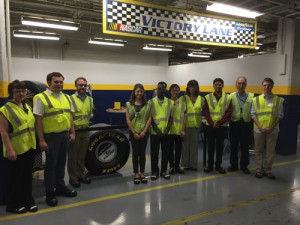Have you ever thought about what could go wrong if the tires on your car were faulty? Tires may seem like simple rubber objects in comparison to the complex vehicles they support, but a team of College of Wooster students learned that it takes a variety of science and engineering techniques to ensure that modern tires perform well.
Emily Howerton ’17, Alexander Iudice ’17, and Khoa Nguygen ’18 know that there is much more that goes into the concept of a tire, and how to deem it safe and usable. As a consulting team, they worked on an Applied Methods and Research Experience (AMRE) project in the summer of 2015. They were also joined by exchange an student, Obed Nsiah, from Ashesi University College in Ghana. Collaborating with Nsiah made their experience unique. “It was really cool to get to know Obed and show him America,” said Howerton.
AMRE is Wooster’s summer consulting program in which teams of students help companies solve real business problems by applying classroom knowledge to practical applications. The students were asked to develop a computer program for Goodyear that would look at the quality control of a tire.
In order to do this, the program needs to detect faults in a tire that would prevent it from performing to the best of its capability. Tires are made up of multiple layers of wires. If the space between the wires is too large or the wires are wavy, the tire is insufficient. The computer program they created detects if the problems exist, and the exact locations of the problems.
At first, the team had a hard time understanding their task at hand. Howerton explained, “A tire has a lot of different layers, and our project dealt specifically with one layer of the tire, which we didn’t quite get at first. None of us had an understanding about the structure of a tire or how it was made. Thus, simply looking at pictures and diagrams made it really difficult to figure out what we were looking at in the images they sent us. After working with the images and asking a lot of questions, we came to have a better understanding of what was going on in them. A few weeks in, we got to tour the Goodyear plant in Akron, which really solidified our understanding, as we got to watch the process live.” After Howerton and her teammates understood the concept, they were able to figure out how to solve the problems and implement their ideas. They developed the computer program to easily analyze the pictures of the tire layers.
Besides presenting their program to their clients many times, they also showcased their final project at the Experiential Learning Symposium. An APEX presentation coach instructed and gave the team tips to help them prepare for their presentation. Since the project is so detailed and complex, it was hard to include all aspects of their experience into their presentation without exceeding their time limit. The students expressed gratitude for the presentation coach after helping the team to convey their project in a concise manner.
The team said that the math courses they have taken at the College helped with reasoning and general problem solving skills, and they used computer science skills to determine the errors. Their hard work and dedication was well worth it because Goodyear is now able to detect complications in their tires, thanks to the program the Wooster students created.
